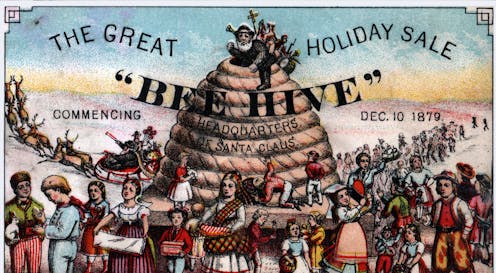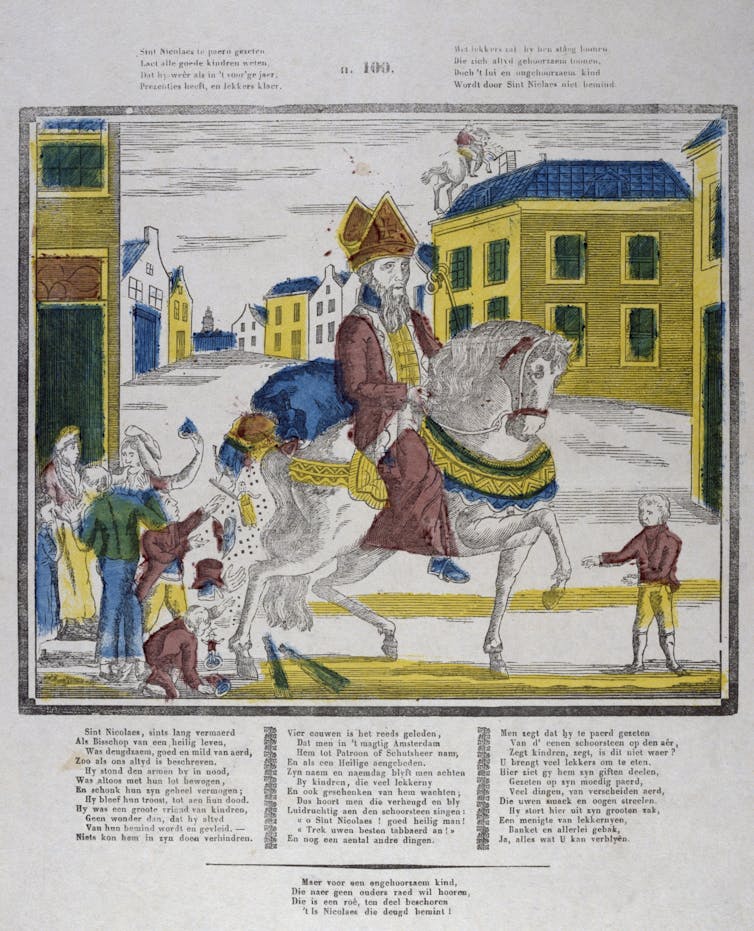Santa, maybe? Why we have different names for who ‘hurries down the chimney’ on Christmas
You may call him Santa Claus, but the bearded guy in the red suit is a man known by many names. That doesn’t make him disreputable, just a reflection of changing American culture.

Everyone has heard of Santa Claus, that chubby, white-bearded, red-suited guy who delivers Christmas presents via a reindeer-powered sleigh.
But have you never wondered how he became a man of so many names? From St. Nick to Santa to Kris Kringle, it’s a marvel that Rudolph isn’t completely confused about whom exactly he is working for.
So, as a linguist who studies the social and historical paths that deliver the words we use, the season’s festive lights and boughs of holly inspired a deep dive into Santa’s past to uncover what name we should really be using for the man in red.
Ho, ho, ho
It might feel like he has been around as long as the North Pole, but the Santa Claus name so frequently mentioned by Americans to refer to old Saint Nicholas come Christmas Eve is a surprisingly recent moniker.
The first written citation for “Santa Claus” does not appear in the U.S. until the late 18th century, where it was alluded to in a mention of a religious event in the New York Gazette: “Last Monday the Anniversary of St. Nicholas, otherwise called St. A Claus, was celebrated at Protestant-Hall.”

The fact that the first citation appeared in New York is not unusual, given New York’s history until 1664 as a Dutch colony and the ongoing presence of Dutch settlers in that area. This Dutch background is key because Santa Claus is in fact a borrowing into English of the Dutch name Sinter Klaas, which sometimes dialectally appeared as Sante Klaas.
Still, before the 1830s, the substitution of Santa Claus for St. Nick was not in frequent use. In fact, prior to vastly increasing in general popularity toward the latter half of the 1800s, its use earlier that century was often to invoke Dutch heritage and culture, as in the satirical writings of Washington Irving.
For instance, a New York-based satirical magazine of the era had this to say in 1808: “The noted St. Nicholas, vulgarly called Santa claus − of all the saints in the kalendar the most venerated by true hollanders, and their unsophisticated descendants.”
But, by the 1820s, a children’s book introduced Sante Claus in a sleigh pulled by reindeer, suggesting that his modern reputation was established by then. His iconic attire, though, didn’t become his standard uniform until a Coca-Cola advertisement depicted him in red-suited splendor over a century later in 1930. Before then, Santa’s outfits had spanned the range from green and yellow to even patriotic stars and stripes.
Old Saint Nick
The popular term for Santa prior to this period was Saint Nicholas, a name known from the religious observance of the Feast Day of St. Nicholas on Dec. 6. The Dutch name, SinterKlaas, is actually a derivative of the name Saint Nicholas.
Historically speaking, the namesake of Saint Nicholas was the highly charitable bishop of a Roman town called Myra during the fourth century. He had become the patron saint of children and was known as a man of great generosity. His background made him an easy candidate for later becoming associated with Christmas, even though he originally was celebrated on an entirely different day and for a different reason.
Whether going by St. Nick or Santa Claus, the man’s enormous celebrity as the grantor of tangible wishes also turned out to be another legacy of the Dutch, for it was their tradition to give small gifts or sweets on St. Nicholas Day. And so, this Dutch tradition inspired the American mythologizing of a man with a sack of presents on his back to be delivered to children throughout the land.

The Kringle wrinkle
Another name for Santa Claus that grew in popularity in the 1800s was the name Kris Kringle. While Santa Claus was Dutch, Kris Kringle came by way of the Germans who first settled in Pennsylvania and then spread out, particularly in the late 1800s.
The name Kris Kringle, though, was unrelated to Saint Nicholas. Instead, it came from the German word Christkindlein, meaning “Christ child,” referring to the baby in the manger. So, unlike St. Nicholas, Kris Kringle is more directly related to the Christian celebration of Christ’s birth.
Over time, however, the feast of St. Nicholas, also celebrated by German immigrants, became increasingly merged with the celebration of Christmas in the U.S. Given the German influx into the United States was much greater than the Dutch during the 1800s, it is not surprising that the German name competed with the Dutch term during much of that period before Americans eventually decided to settle mainly on Santa Claus.
A man of many names
In the end, whether it’s St. Nick, Santa or Kris Kringle who rides his sleigh into the holidays, the history of how he got his name is one that illustrates a wonderful melding of languages and cultures – a reminder of how differences can merge into a rich and varied part of a culture, celebrated by many.
Valerie M. Fridland does not work for, consult, own shares in or receive funding from any company or organization that would benefit from this article, and has disclosed no relevant affiliations beyond their academic appointment.
Read These Next
New materials, old physics – the science behind how your winter jacket keeps you warm
Winter jackets may seem simple, but sophisticated engineering allows them to keep body heat locked in,…
The celibate, dancing Shakers were once seen as a threat to society – 250 years later, they’re part
‘The Testament of Ann Lee,’ Mona Fastvold’s 2025 film, depicts part of the long history of Shaker…
From truce in the trenches to cocktails at the consulate: How Christmas diplomacy seeks to exploit s
World leaders like to talk up peace at Christmastime. But alongside the tales of seasonal breaks in…






